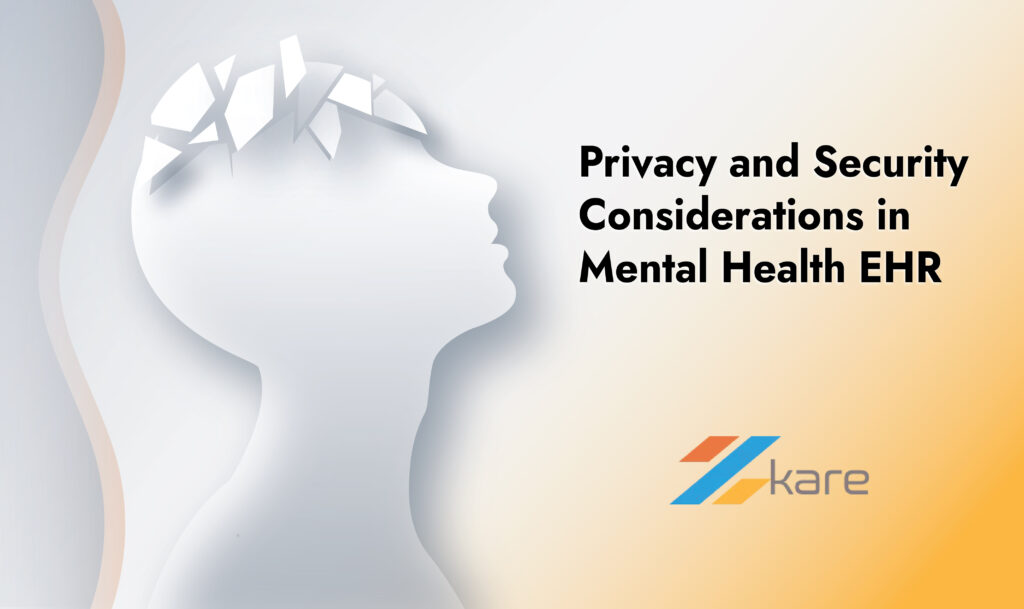
EHR Systems, Mental health EHR
In modern times, adopting electronic medical records (EHR) has transformed the healthcare industry, boosting productivity and enhancing patient care. However, with the advantages of digitising confidential patient data comes important security and privacy issues, especially in mental health records. Safeguarding the privacy, security, and accessibility of mental health EHR is of the utmost significance to protect their sensitive and personal data.
This blog explores multiple key privacy and security considerations concerning mental health EHR. It highlights important steps that healthcare organizations and providers must take to maintain the privacy of patient data and protect against possible security breaches.
Data Encryption
Encryption is a crucial security measure that transforms sensitive data into an unreadable format, called ciphertext, using encrypted algorithms. Robust encryption ensures that even if a third party gains access to the data, they cannot interpret it without the correct decryption keys. Encryption should be applied to confidential information when it is kept in records or servers and while transmitting over other systems.
Access Controls
Access controls play an essential part in protecting mental health records. Role-based access controls (RBAC) restrict system access according to the principle of least privilege, indicating that people are granted only the permissions needed for fulfilling their specific job functions.
By assigning various positions to users, like medical providers, administrators, and support staff, the system can set up access restrictions, facilitating that staff can only access the data needed to provide value-based care. This reduces the risk of unauthorized accessibility to sensitive mental health documents.
Authentication
Authentication is verifying the identity of users obtaining the EHR system. Strong authentication mechanisms, like two-factor authentication (2FA), offer an additional layer of security beyond just using a password and a username.
With 2FA, individuals must provide two distinct kinds of credentials, usually something they know (e.g., a password) and something they have (e.g., a unique code created by an application on their device or a physical token). This provides an additional barrier to unwanted access, as an attacker must have both the username and password and the second factor to gain entry.
Audit Trails
Audit trails assist in monitoring and tracking system activities by recording events like user logins, access attempts, and data modifications. By keeping detailed audit logs, companies can examine the recorded information to identify unapproved access, suspicious activities, or data breaches.
Audit trails also play a vital role in compliance and transparency, offering an accurate record of who accessed the system, which operations were performed, and when. Monitoring and reviewing audit logs frequently enable timely detection and response to security-related problems, as well as helping in investigations if necessary.
Physical Security
Physical security measures are necessary for safeguarding the physical infrastructure and resources hosting the EHR system. It involves the data centres or servers hosted by the electronic health record (EHR). Physical security measures can involve regulated server access through biometric authentication or key card structures, surveillance cameras, and alarms. By implementing these precautions, organizations can avoid unauthorized physical access to computers and infrastructure, decreasing the possibility of data breaches and tampering.
Regular Security Updates and Patching
Maintaining the EHR system and updating its foundational aspects with the latest security patches and updates is essential to preserving a secure environment. Software developers frequently release updates and patches to address new vulnerabilities and security weaknesses. Companies should have an effective patch management process to set up these updates to reduce potential security risks promptly.
Employee Training
Human error is an important component in many safety incidents. Comprehensive training programs should be offered to all employees with access to the Mental Health EHR security. The training should cover password and data handling guidelines, recognizing social cyber attacks, and notifying potential security incidents.
By informing staff members about security and privacy practices, providers can promote a security-conscious culture and encourage staff to make educated choices when handling confidential patient data.
Data Backup and Disaster Recovery
Establishing robust data recovery and backup procedures is essential for the resilience of the Mental Health EHR solution. Regularly backing up patient data and keeping it securely in off-site locations guarantees that the data can be recovered in the case of system failures, natural disasters, or other unforeseen circumstances.
The backup data should be protected to preserve its confidentiality. Organizations should also frequently evaluate and verify the data recovery processes to ensure effectiveness.
Final thoughts
By prioritizing security and confidentiality in mental health EHR systems, healthcare providers can build confidence in patients and encourage trust in the healthcare system while contributing to the overall well-being and recovery of people seeking mental health treatment. Protecting the confidentiality of mental health records is an ethical and legal responsibility and an essential requirement for offering quality mental health care in the digital age.